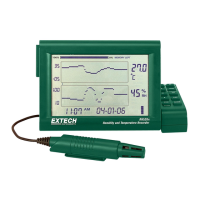2 RH520A-en-GB_v4.8 6/19
Introduction
Congratulations on your purchase of the Extech RH520A Temperature + Humidity Chart
Recorder. The RH520A measures and displays Temperature, Humidity, and Dew Point.
The remote (detachable) probe senses the ambient conditions while the LCD display graphs and
provides numerical representation of the readings. Programmable audio-visual alarms alert the
user when ambient conditions reach alarm presets. The optional alarm module permits
automatic relay switching when alarm presets are reached.
The RH520A Internal Memory can store up to 49,152 measurements for later transfer to a PC.
Careful use of this instrument will provide years of reliable service.
CAUTIONS
This device is not a toy, it contains hazardous objects as well as small parts that children can
swallow. Contact a physician immediately if an object is swallowed.
Do not leave batteries or packing material unattended; they can be dangerous to children.
If the device is to be unused for an extended period, remove the batteries to prevent them
from draining.
Expired or damaged batteries can cause cauterization on contact with the skin. Use
protective gloves when necessary.
Do not short-circuit batteries or discard them in a fire.
FCC Compliance
This equipment has been tested and found to comply with the limits for a Class B digital device, pursuant to
part 15 of the FCC Rules. These limits are designed to provide reasonable protection against harmful
interference in a residential installation. This equipment generates, uses, and can radiate radio frequency
energy and, if not installed and used in accordance with the instructions, may cause harmful interference to
radio communications. However, there is no guarantee that interference will not occur in a particular
installation. If this equipment does cause harmful interference to radio or television reception, which can be
determined by turning the equipment off and on, the user is encouraged to try to correct the interference by
one or more of the following measures:
1. Reorient or relocate the receiving antenna.
2. Increase the separation between the equipment and receiver.
3. Connect the equipment into an outlet on a circuit different from that to which the receiver is connected.
4. Consult the dealer or an experienced radio/TV technician for help.

